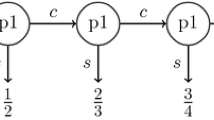Abstract
Security solutions for two stage games, where the second stage consists of a strategic form noncooperative game, are not reachable in many problems. The aim of this paper is to investigate such solutions. Mixed extension for the second stage game is considered and existence results for approximate mixed security solutions, together with the convergences of values, are given and illustrated by significative examples. The results apply to the class of quasi harmonic games.

Similar content being viewed by others
Notes
A correspondence \(\Gamma : X \rightarrow 2^{Y}\) where \(2^{Y} \) is the collection of all subsets of Y, including the empty set \(\emptyset \), is said lower semicontinuous (l.s.c.) at \(x_0\in X\) if \(\Gamma (x_0)=\emptyset \) or for any sequence \(x_n\) converging to \(x_0\) and for any \(y\in \Gamma (x_0)\) there exists a sequence \(y_n\) converging to y such that \(y_n\in \Gamma (x_n)\) for n large.
A correspondence \(\Gamma : X \rightarrow 2^{Y}\) is said closed (closed graph) at \(x_0\in X\) if for every sequence \(x_n\in X\) converging to \(x_0\) and for any sequence \(y_n\) with \(y_n\in \Gamma (x_n)\) converging to some \(y_0\), one has \(y_0\in \Gamma (x_0)\).
Berge theorem (or Maximum theorem Aubin 2007) Given the function \(f: X\times Y \rightarrow \mathbb {R}\) and the correspondence \(\Gamma : X\rightarrow 2^{Y}\), consider the problem
$$v(x)= \displaystyle \sup _{y\in \Gamma (x)} f(x, y).$$Assume that \(v(x)<+\infty \) for every \(x\in X\):
(i) if f is l.s.c. and \(\Gamma \) is l.s.c., then v is l.s.c.
(ii) if f is u.s.c. and \(\Gamma \) is closed and compact valued, then v is u.s.c.
We thank one of the referees for proposing this example.
References
Aubin, J.-P. (2007). Mathematical methods of game and economic theory (revised ed.). Mineola, NY: Dover Publications, Inc.
Başar, T., & Olsder, G. J. (1999). Dynamic noncooperative game theory. Reprint of the second 1995 edition. Classics in Applied Mathematics, 23. Society for Industrial and Applied Mathematics (SIAM), Philadelphia, PA.
Candogan, O., Menache, I., Ozdaglar, A., & Parrilo, P. A. (2011). Flows and decompositions of games: Harmonic and potential games. Math. Oper. Res., 36, 474–503.
Colson, B., Marcotte, P., & Savard, G. M. (2007). An overview of bilevel optimization. Annals of Operations Research, 153, 1–23.
Grammatico, S. (2017). Dynamic control of agents playing aggregative games with coupling constraints. IEEE Transactions on Automatic Control, 62, 4537–4548.
Hofbauer, J. (2011). Deterministic evolutionary game dynamics, in Evolutionary game dynamics, vol. 69 of Proc. Sympos. Appl. Math., Amer. Math. Soc., Providence, RI, pp. 61–79.
Hu, M., & Fukushima, M. (2015). Multi-leader-follower games: Models, methods and applications. Journal of the Operations Research Society of Japan, 58, 1–23.
Luo, Z. Q., Pang, J. S., & Ralph, D. (1996). Mathematical programs with equilibrium constraints. Cambridge: Cambridge University Press.
Mallozzi, L., & Morgan, J. (2001). Mixed strategies for hierarchical zero-sum games. Annals of the International Society of Dynamic Games, 6, Birkhauser Boston, Boston, MA, pp. 65–77
Mallozzi, L., & Morgan, J. (2006). On approximate mixed Nash equilibria and average marginal function for two-stage three players games. Ed. Dempe, S., Kalshnikov V. Optimization with Multivalued Mapping, Springer Optim. Appl., 2, Springer, New York, pp. 97–107
Monderer, D., & Shapley, L. S. (1996). Potential games. Games and Economic Behavior, 14, 124–143.
Morgan, J., & Raucci, R. (2002). New convergence results for Nash equilibria. Journal of Convex Analysis, 6, 377–385.
Sherali, H. D., Soyster, A. L., & Murphy, F. H. (1983). Stackelberg-Nash-Cournot equilibria: Characterizations and computations. Operational Research, 31, 253–276.
von Stackelberg, H. (1952). Marktform und Gleichgewicht. Julius Springer, Vienna (1934). English Edition: The theory of the market economy. Peacock, A. (ed.), London, William Hodge
Acknowledgements
The authors thank the anonymous reviewers for their helpful comments.
Author information
Authors and Affiliations
Corresponding author
Additional information
Publisher's Note
Springer Nature remains neutral with regard to jurisdictional claims in published maps and institutional affiliations.
This work has been supported by GNAMPA 2020, project:“Problemi di ottimizzazione con vincoli via trasporto ottimo e incertezza”.
Rights and permissions
About this article
Cite this article
Mallozzi, L., Sacco, A. Stackelberg-Nash equilibrium and quasi harmonic games. Ann Oper Res 318, 1029–1041 (2022). https://doi.org/10.1007/s10479-020-03916-x
Accepted:
Published:
Issue Date:
DOI: https://doi.org/10.1007/s10479-020-03916-x



